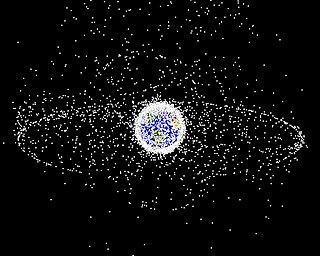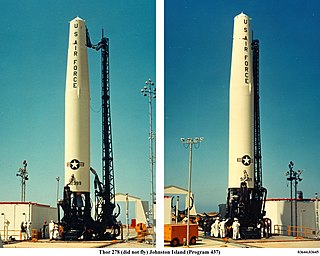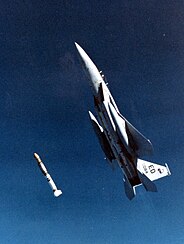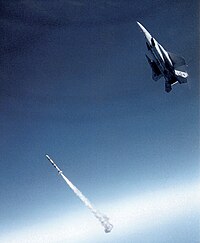
A missile is an airborne ranged weapon capable of self-propelled flight aided usually by a propellant, jet engine or rocket motor.

Anti-satellite weapons (ASAT) are space weapons designed to incapacitate or destroy satellites for strategic or tactical purposes. Although no ASAT system has yet been utilized in warfare, a few countries have successfully shot down their own satellites to demonstrate their ASAT capabilities in a show of force. ASATs have also been used to remove decommissioned satellites.

Space debris are defunct human-made objects in space – principally in Earth orbit – which no longer serve a useful function. These include derelict spacecraft, mission-related debris, and particularly-numerous in-Earth orbit fragmentation debris from the breakup of derelict rocket bodies and spacecraft. In addition to derelict human-made objects left in orbit, space debris includes fragments from disintegration, erosion, or collisions; solidified liquids expelled from spacecraft; unburned particles from solid rocket motors; and even paint flecks. Space debris represents a risk to spacecraft.

Space warfare is combat in which one or more belligerents are situated in outer space. The scope of space warfare therefore includes ground-to-space warfare, such as attacking satellites from the Earth; space-to-space warfare, such as satellites attacking satellites; and space-to-ground warfare, such as satellites attacking Earth-based targets. Space warfare in fiction is thus sub-genre and theme of science fiction, where it is portrayed with a range of realism and plausibility. In the real world, international treaties are in place that attempt to regulate conflicts in space and limit the installation of space weapon systems, especially nuclear weapons.

The Scout family of rockets were American launch vehicles designed to place small satellites into orbit around the Earth. The Scout multistage rocket was the first orbital launch vehicle to be entirely composed of solid fuel stages. It was also the only vehicle of that type until the successful launch of the Japanese Lambda 4S in 1970.

The Kessler syndrome, proposed by NASA scientist Donald J. Kessler in 1978, is a scenario in which the density of objects in low Earth orbit (LEO) due to space pollution is numerous enough that collisions between objects could cause a cascade in which each collision generates space debris that increases the likelihood of further collisions. In 2009, Kessler wrote that modeling results had concluded that the debris environment was already unstable, "such that any attempt to achieve a growth-free small debris environment by eliminating sources of past debris will likely fail because fragments from future collisions will be generated faster than atmospheric drag will remove them". One implication is that the distribution of debris in orbit could render space activities and the use of satellites in specific orbital ranges difficult for many generations.

Program 437 was the second anti-satellite weapons program of the U.S. military. The US anti-satellite weapons program began development in the early 1960s and was officially discontinued on 1 April 1975. Program 437 was approved for development by U.S. Secretary of Defense Robert McNamara on November 20, 1962, after a series of tests involving high altitude nuclear explosions. The program's facilities were located on Johnston Island, an isolated island in the north central Pacific Ocean.
On 11 January 2007, China conducted an anti-satellite missile test. A Chinese weather satellite—the FY-1C polar orbit satellite of the Fengyun series, at an altitude of 865 kilometres (537 mi), with a mass of 750 kilograms (1,650 lb)—was destroyed by a kinetic kill vehicle traveling with a speed of 8 km/s (18,000 mph) in the opposite direction. It was launched with a multistage solid-fuel missile from Xichang Satellite Launch Center or nearby.

Space Systems Command (SSC) is the United States Space Force's space development, acquisition, launch, and logistics field command. It is headquartered at Los Angeles Air Force Base, California and manages the United States' space launch ranges.

USA-193, also known as NRO Launch 21, was a United States military reconnaissance satellite launched on 14 December 2006. It was the first launch conducted by the United Launch Alliance (ULA). Owned by the National Reconnaissance Office (NRO), the craft's precise function and purpose were classified. On 21 February 2008, it was destroyed as a result of Operation Burnt Frost.

P78-1 or Solwind was a United States satellite launched aboard an Atlas F rocket from Vandenberg Air Force Base in California on February 24, 1979. The satellite's mission was extended by several weeks, so that it operated until it was destroyed in orbit on September 13, 1985, to test the ASM-135 ASAT anti-satellite missile.
The Integrated Space Cell was the nodal agency within the Government of India with oversight of the security of its space based military and civilian hardware systems. It was to be jointly operated by all the three services of the Indian Armed Forces, the civilian Defence Research and Development Organisation and the Indian Space Research Organisation (ISRO). This agency was superseded by Defence Space Agency in 2019.[better source needed]
Strictly speaking, a satellite collision is when two satellites collide while in orbit around a third, much larger body, such as a planet or moon. This definition can be loosely extended to include collisions between sub-orbital or escape-velocity objects with an object in orbit. Prime examples are the anti-satellite weapon tests.

Operation Burnt Frost was a military operation to intercept and destroy non-functioning U.S. National Reconnaissance Office (NRO) satellite USA-193. The mission was described by the Missile Defense Agency as a "mission of safeguarding human life against the uncontrolled re-entry of a 5,000-pound satellite containing over 1,000 pounds of hazardous hydrazine propellant". The launch occurred on 21 February 2008 at approximately 10:26 p.m. EST from the USS Lake Erie, using a heavily modified Standard Missile-3 (SM-3) to shoot down the satellite. A few minutes after launch, the SM-3 intercepted its target and successfully completed its mission. The operation received scrutiny from other countries, mainly China and Russia.

The Bold Orion missile, also known as Weapons System 199B (WS-199B), was a prototype air-launched ballistic missile (ALBM) developed by Martin Aircraft during the 1950s. Developed in both one- and two-stage designs, the missile was moderately successful in testing, and helped pave the way for development of the GAM-87 Skybolt ALBM. In addition, the Bold Orion was used in early anti-satellite weapons testing, performing the first interception of a satellite by a missile.

The High Virgo, also known as Weapons System 199C (WS-199C), was a prototype air-launched ballistic missile (ALBM) jointly developed by Lockheed and the Convair division of General Dynamics during the late 1950s. The missile proved moderately successful and aided in the development of the later GAM-87 Skybolt ALBM. It was also used in early tests of anti-satellite weapons.
China's anti-satellite (ASAT) program has been under development since 1964. The ASAT program has since been moved from Program 640 to Program 863, the General Armaments Department and the State Administration for Science, Technology and Industry for National Defense. Since its inception, the ASAT program has made progress on the development of three ASAT capable Systems: direct fire, directed-energy weapon, and microsatellites. Tests of these systems have either been directly acknowledged by the PRC, or reported on as ASAT capable. China is pursuing a broad and robust array of counterspace capabilities, which includes direct-ascent antisatellite missiles, co-orbital antisatellite systems, computer network operations, groundbased satellite jammers, and directed energy weapons.

Microsat-R was claimed to be an experimental imaging satellite manufactured by DRDO and launched by Indian Space Research Organisation on 24 January 2019 for military use. The satellite served as a target for an anti-satellite test on 27 March, 2019.

On 27 March 2019, India tested an anti-satellite weapon (ASAT) during an operation code named Mission Shakti. The target of the test was a satellite present in a low Earth orbit, which was hit with a kinetic kill vehicle.

Kosmos-1408 was an electronic signals intelligence (ELINT) satellite operated by the Soviet Union. It was launched into low Earth orbit on 16 September 1982 at 14:55 UTC, replacing Kosmos-1378. It operated for around two years before becoming inactive and left in orbit.




















